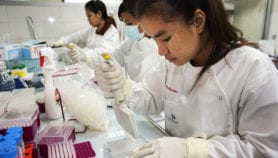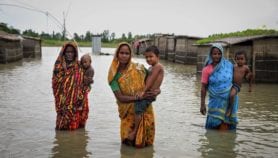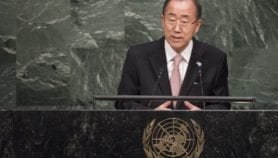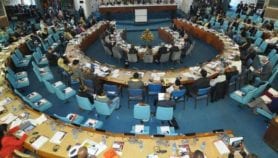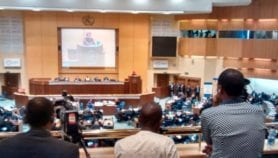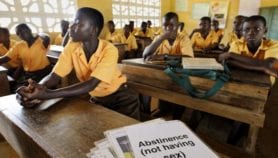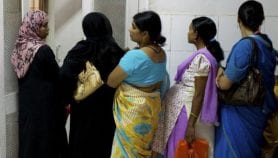Send to a friend
The details you provide on this page will not be used to send unsolicited email, and will not be sold to a 3rd party. See privacy policy.
Nalaka Gunawardene argues that better communication is needed to convey the urgency of the Millennium Development Goals — and the role of science in achieving them — to the public.
How can we get the public and governments to take the United Nations’ Millennium Development Goals (MDGs) more seriously? This question is likely to be high on the agenda of delegates from UN member states as they gather in New York this week to discuss progress towards achieving the goals, set in 2000 to tackle poverty, hunger and disease worldwide.
It was also debated recently by a group of Asia’s top development experts and UN officials in a meeting at the Asian Development Bank in Manila, the Philippines. The occasion was the launch of a new report, A Future Within Reach, which looked at how countries in the Asia- Pacific region are faring in their pursuit of the goals.
The eight MDGs come with a set of 18 specific targets and 48 indicators. They cover a broad spectrum of goals, from halving poverty and hunger to combating HIV, tuberculosis and malaria, all to be met by 2015.
The new report, published jointly by the UN-ESCAP, the United Nations Development Programme (UNDP) and the Asian Development Bank, gave the Asia Pacific region — home to 60 per cent of humanity — a mixed score card. It noted that none of the countries in the region is currently on track to meet all the goals.
As political activists prepared for yet another demonstration not too far away from the Manila meeting hall, stakeholders inside debated why, despite their clear importance, the MDGs have failed to capture popular imagination. Even among government officials, it was noted, levels of awareness and enthusiasm varied considerably.
The answer was staring us in the face. All around us in the hall were colourful posters and banners urging us to ‘eliminate gender disparity’, ‘reduce child mortality’ and ‘integrate the principles of sustainable development into country policies and programmes’.
But these lofty phrases illustrated the chasm between the charmed development circle meeting inside the air-conditioned comfort of the bank and the real world on Manila’s chaotic streets outside.
Suddenly, it became clear to me why the MDGs were not catching on: nobody was expressing the goals in simple enough words that most people — including non-specialists like myself — could understand.
Junk the jargon
Just like computer ‘geeks’, development workers speak in jargon, using countless acronyms that obfuscate rather than communicate. Scientists, who often complain that the public does not understand their work, tend to make exactly the same mistake — with similar results.
Ernest Rutherford, the first scientist to split the atom, once told his students: "If you can’t explain to the person who cleans the lab floor the essence of your work, you don’t know what you are doing".
All development workers and UN officials should take a simple test: explain to the least technical person in your office the core message and relevance of your work. Many jargon-using, data-wielding, acronym-loving development workers would probably fail this test. But unless development-speak is translated into simpler language, the MDGs will remain a buzzword confined to development experts and activists.
Unless, that is, we find a quick and cheap way of cloning musicians such as Bob Geldof and Bono. With some help from fellow entertainers, these two celebrities have, though the recent Live Aid concerts, managed to generate mass attention to banishing poverty in a way that poverty studies experts could never accomplish. The main reason: they spoke the universal language of music.
The world needs both the hair-splitting technical experts who study problems in depth and detail, and good communicators who take on headline concerns and turn them into popular campaigns. Jeffrey Sachs and Bono make a good pair.
Yet every expert can play his or her part in advocacy and communications. As the world leaders come together at the UN headquarters, the development community urgently needs to find better ways of engaging the non-technical public.
Message through the media
One effective way of doing this is to work with the many media outlets that have a level of access to mass audiences that development agencies can only dream about. But engaging the media requires the right attitudes and skills. Here are a few helpful hints:
- Go beyond the ‘broadsheet’ mentality. Broadsheet newspapers are influential with policymakers and business leaders. But mass outreach is with the tabloids — and their broadcast equivalents. News does not have to be sensational to get coverage. But stories have to be well told and well packaged to interest the media.
- Try the ‘NIT’ test: Before reaching out to the media with a story or opinion piece, ask three basic questions: Is it new? Is it interesting? And is it true? A triple hit enhances chances of media interest.
- Rise above mere publicity. The trouble with many UN agencies and development charities is that they do not differentiate between institutional publicity and awareness-raising. The latter is far more important in shaping public policy agendas. Yet much time, effort and money are spent on publicity that massages the egos of a few. Living in Sri Lanka, I saw this happen repeatedly in the aftermath of the Asian tsunami. Every agency and charity wanted its 15 minutes of fame.
- Move away from ‘geekspeak’: The intellectual rigours of evidence-based, scientific analysis must be balanced with clarity and accessibility. It is good to be informed by science, but learn to say it simply, clearly and concisely. Do not hesitate to use terms, metaphors and analogies from popular culture.
These home truths are not new. But they bear repetition. Three years ago, the UN Environment Programme (UNEP) asked colleague Robert Lamb and myself to recommend a global strategy to communicate the ozone message.
We had to look at the remaining challenges of phasing out the few dozen man-made chemicals damaging the ozone layer. Many think the ozone problem has been fixed, but there is much unfinished business, and also a danger of backsliding and failing to meet internationally agreed targets.
We stressed to UNEP the crucial need to engage the popular media, especially broadcast television — now the world’s most powerful medium. We also studied dozens of successful campaigns in development communications and distilled the following hallmarks of a powerful message that grips and changes people across cultures and borders.
- Easy-to-understand language;
- Unambiguous messages;
- Personal appeal to individuals’ emotions;
- Evidence-based yet not too technical;
- Suggesting options or allowing room for personal action.
Learning from the past
Today’s MDG promoters need to revisit some of the more successful development efforts of the past few decades — such as promoting universal human rights, eradicating smallpox, popularising oral rehydration salts, and wiping out Southern debt — and study the role good communications played in each.
Those in the UN system, in particular, have to find more creative ways of getting the MDG message across. In my view, MDG ‘branding’ is not what is important; it is the core set of issues that MDGs embody that need mass attention and aggressive promotion.
We should also invoke the memory of past visionary leaders who navigated the treacherous inter-governmental minefields to talk truth to power. One was James Grant, former executive director of the UN children’s agency, turned UNICEF into a formidable global brand.
One of Grant’s enduring remarks concerned the silent emergency of several thousand children (and adults) dying everyday from preventable diarrhoeal diseases. It was, he pointed out repeatedly, as if several jumbo jets full of children were crashing everyday — and nobody took any notice.
That metaphor might lack political correctness in the post-11 September era. But the message was loud and clear. Grants’ one time deputy at UNICEF, Tarzie Vittachi, was another master at summing up complex development issues in memorable ways. When he was head of information at the UN population agency, the former newspaper editor used to remind everyone: ‘Governments don’t have babies; people do.’
It is these ‘real world’ people who lose their babies to preventable childhood diseases; or drop out of school because they cannot afford to stay on; or die needlessly in their millions during pregnancy or childbirth; or go to bed hungry every night.
MDGs address these and other real world issues with a sense of urgency. We just need to better engage the human beings we are trying to empower. 2015 will be here sooner than we expect. We do not want to find that we missed the chance of a millennium — to do a few things right in development — because we were too busy chattering amongst ourselves.
Nalaka Gunawardene is director of TVE Asia Pacific (www.tveap.org), a non-profit organisation specialising in communicating development using television, video and new media. The views in this editorial are entirely his own.


